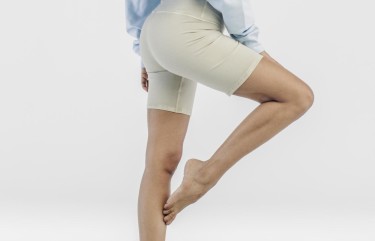EVLT: What You Need to Know
Pros & cons
How much it costs
What to expect
How long healing takes
How it feels
How soon you see results
Fast facts
Endovenous laser treatment (EVLT or ELT), also known as endovenous laser ablation (EVLA), is a minimally invasive procedure that treats varicose veins. These large, often bulging veins are created by venous insufficiency or venous reflux disease, which happens when the valves in your veins don’t work properly.
“Healthy leg veins contain valves that open and close, to help the blood return back to the heart,” explains Dr. Michael Nguyen, a board-certified phlebologist in NYC, in a RealSelf Q&A. “Venous reflux disease develops when the valves that keep blood flowing out of the legs and back to the heart no longer function, causing blood to pool in the legs.” The collected blood creates pressure, making them expand and bulge. The enlarged vein may be deep in your tissue or visible through your skin.
Though varicose veins are usually benign, they can cause pain and discomfort or lead to complications like ulcers and blood clots. Symptoms like swelling, heaviness, fatigue, and cramping in the legs can be signs of chronic venous insufficiency.
An EVLT procedure uses laser energy to close off the diseased veins, which shrink over the next few weeks until they're no longer noticeable. Blood flow is redirected from the affected veins to healthy veins, improving blood circulation.
RealSelf Tip: The pressure from varicose veins can also spread through your vascular system and cause spider veins, meaning that those smaller, surface-level veins may indicate a deeper circulation issue.
Pros
- EVLT both improves the appearance of noticeable veins and relieves symptoms of discomfort, heaviness, and fatigue.
- The procedure is minimally invasive, with no downtime. You can go about your day immediately after your appointment.
- Because varicose veins are typically a sign of underlying circulation issues, this procedure may be covered by your health insurance.
Cons
- Like other vein treatments, EVLT won’t prevent future varicose veins. Relieving the pressure in one treated vein can reduce pressure in the overall vascular system, but other veins with faulty valves can still become varicose later on.
- If you have multiple varicose veins, you may need several treatment sessions.
- Spider veins (the smaller, surface-level veins) may not be reduced. If you want to get rid of those, you'll need to consider other treatment options, like sclerotherapy.
- Risks include deep vein thrombosis, infections, and scarring, so talk to your healthcare provider (ideally a vein specialist, such as a board-certified vascular surgeon) to make sure you're a good candidate.
- Average Cost:
- $1,725
- Range:
- $900 - $4,791
What you’ll pay for EVLT depends on how many veins are treated and your insurance coverage. Many insurance providers offer full or partial coverage of EVLT, when it’s deemed medically necessary. You’ll need to have ultrasound scans that show venous insufficiency or venous reflux disease to obtain insurance coverage.
The EVLT procedure is quick (less than an hour) and has no downtime. It’s an outpatient procedure performed in office, with local anesthesia, typically by a phlebologist or radiologist.
If you have multiple varicose veins, your doctor may recommend separate treatment sessions. It depends on the size and location of the veins, how much anesthesia is needed, and what your insurance provider dictates.
Your provider will use ultrasound to map the vein. Then they'll inject it with an anesthetic along its entire length, to numb the surrounding tissue.
They'll make a small incision on the inside of the knee and insert a catheter with a laser fiber directly into the saphenous vein, using ultrasound to guide it. This shouldn’t be painful, but it will feel a bit like getting an IV placed.
The laser emits short bursts of energy that heat the vein and cause it to collapse.
Once the catheter is pulled out, the incision will be closed with a small bandage. You'll put on a pair of compression stockings, and your doctor will have you walk around for at least 20 minutes, to increase blood flow in healthy veins and minimize bruising or swelling.
You can return to normal activities immediately afterward, with minimal or no discomfort.
You’ll be asked to wear the compression socks regularly for the first week after treatment, though many doctors on RealSelf recommend wearing them for even longer. Compression socks help reroute the blood around the sealed vein, through a new set of vessels.
Several days after your procedure, you’ll return for a follow-up appointment and an ultrasound scan, to make sure the targeted vein is fully closed and you haven't developed blood clots.
A local anesthetic (rather than general anesthesia) usually makes the procedure relatively comfortable for most people, particularly compared to other options for the treatment of varicose veins, such as vein stripping. The laser doesn't touch the vein wall, which also helps minimize discomfort.
You'll start to see results within a week, but it can take up to a few months for visible varicose veins to fully diminish.
New varicose veins can still form after your treatment, which shuts down only specific veins rather than correcting overall venous insufficiency.
If you’re genetically predisposed to varicose veins, talk to your doctor about what you can do to help prevent more. It’s generally recommended that you maintain a healthy weight, exercise regularly, and avoid standing or sitting for long periods of time.
Updated June 13, 2023

